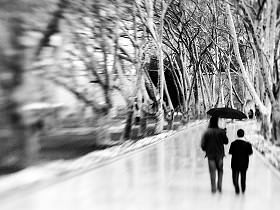----------------------------------------------------------------------------------------------------------------------------
Digital Photography—Reveal More in Black and White
Written by AdministratorYou live in a world of color, so it’s understandable that you’d want to capture all that color in your digital photos. Oddly enough, a full-color picture doesn’t always reveal everything about the subject or object you photograph. When you learn about contrast, light, perspective and texture, you’ll discover that black and white images can tell more of the story of the person in a portrait or reveal qualities of objects or places that color cannot.
After all, Ansel Adams, one of the most popular photographers and quite possibly the greatest landscape photographer, is best known for his black and white pictures of Yosemite and other grand wild places, which you’d expect to see in glorious full color. His photos, however, show you something deeper about those places: their bones, structure and relationship to the total environment. Color is so fascinating to the eye and mind that it tends to cover the rest of the message that exists in every photo. You may not become the next Ansel Adams, but, with the tips in this article, you’ll learn to see and photograph the world differently and add a new chapter to your digital photography experience.
Contrast
Portraits can be particularly stunning as black and white images. With the “distraction” of the color eliminated, you can concentrate on revealing more about the personality of your subject. Black and white photography also allows you to create a mood, with lighting, that complements or contrasts with your subject.
Light
Controlling contrast with light is the secret to giving your portrait photos that striking look. If you shot someone’s portrait according to the automatic exposure system in your camera, then you would have a digital photo with a very even scale of gray tones throughout the image. It’s essentially a color photo, with the color removed. What makes a black and white portrait more revealing and dramatic is when some or all of those gray tones are also eliminated.
 You do that with light. Intensify the light on one part of the person’s face and it becomes white; while the eye socket on the other side of the face is filled with a deep shadow, making it black. Experiment; move your light source and the subject of your portrait into different positions and angles as well as closer and farther. Observe the effect the light has on the person’s face. You’ll discover many amazing portraits to take.
You do that with light. Intensify the light on one part of the person’s face and it becomes white; while the eye socket on the other side of the face is filled with a deep shadow, making it black. Experiment; move your light source and the subject of your portrait into different positions and angles as well as closer and farther. Observe the effect the light has on the person’s face. You’ll discover many amazing portraits to take.Whether you’re shooting portraits in your home studio or during a vacation, you should be even more conscious of the light sources available to you than if you were shooting in color. Because you don’t have as much control of the light when taking portraits outdoors in natural light, it’s a good idea to be equipped with artificial light sources and aids. If you have no choice but to take a picture of a person backlit by the sun, then use your flash to illuminate the subject’s face. Use the same technique if the person is standing under a tree or in a deep shadow. If you invested in reflectors or umbrellas for a home studio, then those can also help create wonderful outdoor portraits in black and white.
Perspective
Black and white digital photography is a perfect opportunity to learn how important perspective is to all photography. Don’t just move your subject (or object) and light source to different positions and relationships, but also move the camera. A full-face picture may identify a person, but shooting from various angles, and with different lighting combinations, can produce a much more interesting, and revealing, portrait.
Texture
With the color removed from the surfaces in your digital black and white photos, suddenly the textures of those surfaces are revealed, and can add much to the composition of your black and white pictures. Place the light source in different positions and you may record the slight imperfections of the skin or emphasize the rough grain of wood, the bark of a tree or the lines in the palm of a hand.
You use the techniques of contrast, light, perspective and texture to create black and white photos in the camera, but those same techniques apply when you use photo-editing software to make black and white digital photos from the original color images. Even though the software allows detailed editing and the use of various effects, keep your editing within the boundaries of what you’ve learned in this article. Understanding and using contrast, light, perspective and texture will always be the key to the best digital black and white photography.
Published in Photography Articles
나도 조만간 DSLR 장만 할 꺼임 ㅋ
ReplyDeleteㅋㅋㅋ 우리 출사함 다같이 가야안되겠소!! :)
ReplyDelete